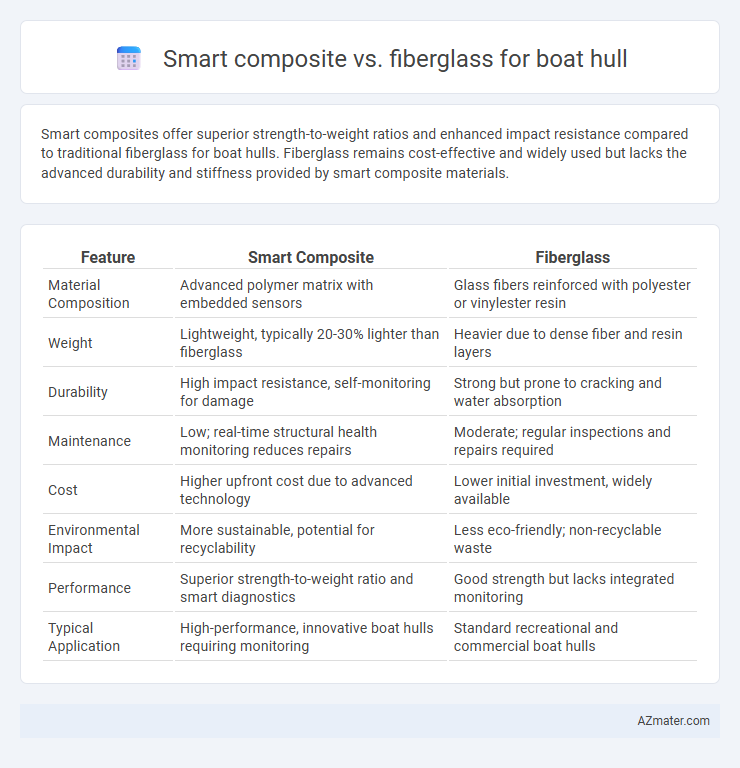Smart composites offer superior strength-to-weight ratios and enhanced impact resistance compared to traditional fiberglass for boat hulls. Fiberglass remains cost-effective and widely used but lacks the advanced durability and stiffness provided by smart composite materials.
Table of Comparison
| Feature | Smart Composite | Fiberglass |
|---|---|---|
| Material Composition | Advanced polymer matrix with embedded sensors | Glass fibers reinforced with polyester or vinylester resin |
| Weight | Lightweight, typically 20-30% lighter than fiberglass | Heavier due to dense fiber and resin layers |
| Durability | High impact resistance, self-monitoring for damage | Strong but prone to cracking and water absorption |
| Maintenance | Low; real-time structural health monitoring reduces repairs | Moderate; regular inspections and repairs required |
| Cost | Higher upfront cost due to advanced technology | Lower initial investment, widely available |
| Environmental Impact | More sustainable, potential for recyclability | Less eco-friendly; non-recyclable waste |
| Performance | Superior strength-to-weight ratio and smart diagnostics | Good strength but lacks integrated monitoring |
| Typical Application | High-performance, innovative boat hulls requiring monitoring | Standard recreational and commercial boat hulls |
Introduction to Modern Boat Hull Materials
Smart composites integrate advanced materials like carbon fiber and epoxy resins to enhance strength, durability, and lightweight properties in modern boat hulls. Fiberglass remains a popular choice due to its cost-effectiveness, ease of repair, and corrosion resistance. Selecting between smart composites and fiberglass depends on performance requirements, budget, and maintenance considerations for marine applications.
What Are Smart Composite Materials?
Smart composite materials in boat hulls integrate sensors and responsive elements to enhance structural performance and durability, enabling real-time monitoring of stress and damage. Unlike traditional fiberglass, smart composites combine fiber reinforcements with embedded technologies such as piezoelectric sensors or shape-memory alloys to provide adaptive strength and self-healing capabilities. This innovation optimizes hull resilience and maintenance efficiency, crucial for marine applications requiring high safety and longevity.
Understanding Traditional Fiberglass Hulls
Traditional fiberglass hulls consist of woven fiberglass mats bonded with polyester or epoxy resin, offering durability and resistance to corrosion and water damage. This material's lightweight nature and cost-effectiveness make it a popular choice for boat construction, providing a strong yet flexible structure that can absorb impacts. However, fiberglass hulls may require regular maintenance to prevent osmosis and degradation over time compared to newer smart composite alternatives.
Strength and Durability Comparison
Smart composite boat hulls combine advanced fibers like carbon and aramid with resin matrices, offering superior strength-to-weight ratios and enhanced impact resistance compared to traditional fiberglass. Fiberglass hulls provide good durability and resistance to corrosion but generally fall short in tensile strength and long-term fatigue performance. The smart composite materials exhibit increased stiffness and longevity, making them a preferred choice for high-performance and long-lasting marine applications.
Weight and Performance Analysis
Smart composite boat hulls significantly reduce overall weight compared to traditional fiberglass, enhancing speed and fuel efficiency. The advanced materials in smart composites provide superior strength-to-weight ratios, resulting in improved impact resistance and durability under stress. Performance analysis shows smart composites enable better maneuverability and acceleration due to their lightweight construction without compromising structural integrity.
Maintenance and Longevity Factors
Smart composite boat hulls offer enhanced durability and reduced maintenance due to their advanced fiber and resin matrix, which resists corrosion, UV damage, and impacts better than traditional fiberglass. Fiberglass hulls, while less costly initially, require more frequent repairs and maintenance such as gelcoat refinishing and osmosis treatment, impacting their longevity in marine environments. The superior performance of smart composites translates into longer service life and lower total ownership cost compared to fiberglass hulls.
Cost Implications and Budget Considerations
Smart composite materials for boat hulls typically offer higher upfront costs compared to fiberglass due to advanced manufacturing techniques and material quality. Fiberglass remains a budget-friendly option, providing durability and ease of repair while maintaining lower production expenses. When evaluating cost implications, smart composites may reduce long-term maintenance and improve performance, potentially offsetting initial investments in budget-conscious projects.
Environmental Impact and Sustainability
Smart composites for boat hulls often utilize advanced bio-based resins and recycled fibers, significantly reducing carbon footprint and promoting sustainability compared to traditional fiberglass. Fiberglass manufacturing involves energy-intensive processes and generates non-biodegradable waste, posing long-term environmental challenges. Choosing smart composites enhances eco-friendly boat design by minimizing harmful emissions and facilitating easier recycling at the end of the hull's lifespan.
Applications in Recreational and Commercial Boating
Smart composite materials offer enhanced strength-to-weight ratio and improved impact resistance over traditional fiberglass, making them ideal for high-performance recreational boats requiring speed and durability. Fiberglass remains a cost-effective, widely used option in commercial boating applications due to its ease of fabrication and proven long-term durability. Recreational vessels benefit from smart composites' flexibility and corrosion resistance, while fiberglass supports large-scale commercial fleets with lower maintenance needs and established repair techniques.
Choosing the Best Material for Your Boat Hull
Smart composite materials offer superior strength-to-weight ratios and enhanced durability compared to traditional fiberglass, making them an excellent choice for high-performance boat hulls. Fiberglass remains popular for its affordability, ease of repair, and widespread availability, which suits recreational and budget-conscious boaters. Evaluating factors such as weight, cost, maintenance, and intended use helps in choosing the best material for your boat hull, with smart composites favored for speed and resilience, and fiberglass preferred for cost-effectiveness and versatility.

Infographic: Smart composite vs Fiberglass for Boat hull
 azmater.com
azmater.com